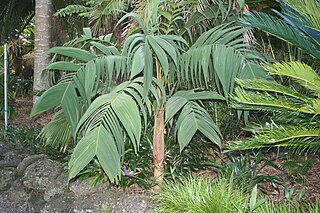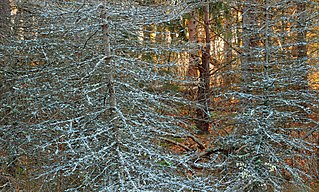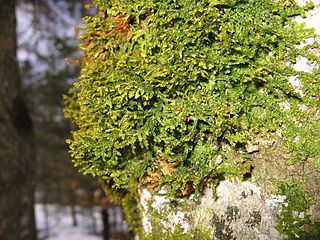
A spruce is a tree of the genus Picea, a genus of about 40 species of coniferous evergreen trees in the family Pinaceae, found in the northern temperate and boreal (taiga) regions of the Earth. Picea is the sole genus in the subfamily Piceoideae. Spruces are large trees, from about 20 to 60 m tall when mature, and have whorled branches and conical form.

The spruce grouse, also known as Canada grouse, spruce hen or fool hen, is a medium-sized grouse closely associated with the coniferous boreal forests or taiga of North America. It is the only member of the genus Canachites.

The Tortricidae are a family of moths, commonly known as tortrix moths or leafroller moths, in the order Lepidoptera. This large family has over 11,000 species described, and is the sole member of the superfamily Tortricoidea, although the genus Heliocosma is sometimes placed within this superfamily. Many of these are economically important pests. Olethreutidae is a junior synonym. The typical resting posture is with the wings folded back, producing a rather rounded profile.

Micromonospora is a genus of bacteria of the family Micromonosporaceae. The genus name was first proposed in 1923 by Danish physician Jeppe Ørskov in an attempt to classify what at the time was considered "ray fungi" based on morphology. Members of this genus are found throughout natural soil and sediment environments, as well as in association with roots of plants of various species. The genus is well known for its ability to produce a variety of medically relevant products.
Silviculture is the practice of controlling the growth, composition/structure, as well as quality of forests to meet values and needs, specifically timber production.

Picea glauca, the white spruce, is a species of spruce native to the northern temperate and boreal forests in North America. Picea glauca is native from central Alaska all through the east, across western and southern/central Canada to the Avalon Peninsula in Newfoundland, and south to Montana, North Dakota, Minnesota, Wisconsin, Michigan, Upstate New York and Vermont, along with the mountainous and immediate coastal portions of New Hampshire and Maine, where temperatures are just barely cool and moist enough to support it. There is also an isolated population in the Black Hills of South Dakota and Wyoming. It is also known as Canadian spruce, skunk spruce, cat spruce, Black Hills spruce, western white spruce, Alberta white spruce, and Porsild spruce.

Virola is a genus of flowering plants in the nutmeg family, Myristicaceae. It includes medium-sized trees native to rainforests of the tropical Americas, ranging from southern Mexico to Bolivia and southern Brazil. Species are known commonly as epená, patricá, or cumala. They have glossy, dark green leaves and clusters of tiny yellow flowers, and may emit a pungent odor.

Fluminimaggiore is a comune (municipality) in the Province of South Sardinia in the Italian region Sardinia, located about 60 kilometres northwest of Cagliari and about 30 km (19 mi) north of Carbonia.

Geonoma is a genus of small to medium-sized palms native to the forest understorey of tropical Central and South America.

Wettinia is a genus of flowering plants in the palm family Arecaceae. The genus, established in 1837, contains some 20 species, but more seem to await discovery considering that 4 species - W. aequatorialis, W. lanata, W. minima and W. panamensis - were described as late as 1995. The genus is broadly divided into two groups. One group has the fruits tightly packed, while the other, formerly classified as genus Catoblastus, has fruits scattered along the inflorescence branches. It is not known whether these groups are both monophyletic. The genus is named after Frederick Augustus II of Saxony, of the House of Wettin.

Cytospora is a genus of ascomycete fungi. The genus was first described in 1818 by Christian Gottfried Ehrenberg. Cytospora species are known as plant pathogens.

Ips is a genus of beetles in the family Curculionidae, the true weevils. They are bark beetles, members of the subfamily Scolytinae. Species are distributed throughout the Northern Hemisphere. Some are known as introduced species in Australia and Africa. Many species are pests of forest trees, especially pines and spruces. They are known commonly as engraver beetles, ips engraver beetles, and pine engravers.

Porellales is an order of liverworts.
Ilumatobacter is a genus from the order Acidimicrobiales.
Ilumatobacter fluminis is a Gram-positive, aerobic, rod-shaped, and non-motile bacterium from the genus Ilumatobacter, which has been isolated from sediments from the mouth of the Kuiragawa River in Japan.
Camelimonas is a genus of bacteria from the order of Hyphomicrobiales.
Camelimonas fluminis is a Gram-negative, aerobic, short rod-shaped and non-spore-forming bacteria from the genus of Camelimonas which has been isolated from water from the Hanjiang River in Wuhan in China. Camelimonas fluminis has the ability to degrade cyhalothrin.
Marichromatium is a genus in the phylum Pseudomonadota (Bacteria). The name Marichromatium derives from: Latin mare, the sea; Neo-Latin Chromatium, a genus name; to give Marichromatium, the Chromatium of the sea, the truly marine Chromatium.
Solimonas is a genus of bacteria from the family of Nevskiaceae.
The estuary croaker is a species of ray-finned fish belonging to the family Sciaenidae, the drums and croakers. It is the only species in the monospecific genus Sonorolux. The estuary croaker is found in estuaries in Sarawak on Borneo.











